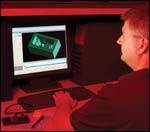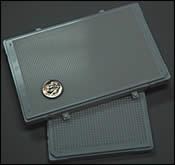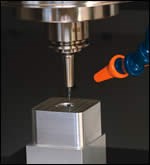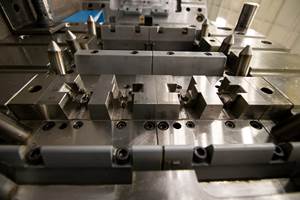Machining/EDM Combo Packs a Powerful Punch
This moldmaker’s new machining center and EDM offer versatility with the ability to machine a number of materials and EDM small holes with ease.
Plastic Design Corp. (Scottsdale, AZ) isn’t your run-of-the-mill moldmaking shop. This 14-person shop calls itself an engineering service—its main goal is to work with an OEM to get its product ready for manufacturing by provid-ing tool design and product design assistance. With micro-machining capabilities a vital part of this work, the company turned to Makino to provide the versatile equipment needed to micro machine medical molds in a cleanroom environment.
According to Plastic Design Corp. President Mark Kinder, the company got started when he was with the Tech Group. “Several of our customers were requesting engineering services,” Kinder recalls. “We had the talent within the Tech Group but we didn’t have it organized in a way that we could sell that product to the customer. I ended up writing a business plan for the Tech Group. At the time they had just invested heavily in Puerto Rico and didn’t wish to start a new division. So—with their blessing—I ended up taking that business plan and starting Plastic Design Corporation. They still are a very good customer of ours.”
As the company grew, took on more projects, and outsourced its rapid prototyping work, Kinder realized he wasn’t satisfied with the quality of the work he was sending out, so the company started a small, in-house toolroom. “That led to in-house molding; and today, the prototype moldmaking and prototype molding represent the majority of our business—although we also still do product design work.”
After initially venturing into the electronics market, Plastic Design found a niche in the medical field in late 1995 and early 1996. “As we developed prototype capabilities we were prototyping medical parts, which forced us into cleanroom molding. Initially we were using portable cleanrooms. Eventually we built a Class 100,000 cleanroom, which opened that market up for us.”
Micro Machinations
Today, with medical and lab ware comprising approximately 90 percent of the company’s business in both mold design and molding, Plastic Design does a great deal of low-volume production and prototype work. “Much of the lab ware has smaller configurations; micro titre plates having wells less than a millimeter in diameter and micro fluidic chips with small channels,” Kinder explains. “There is a lot of development with the Lab on a Chip concept, where through the use of micro fluidic circuits, all of the processes needed for a lab test can occur on a plastic plate no larger than three by five inches.” This is where the micro fluidic circuits, small channels, 100 micron and smaller come into play. The OEMs in this area are trying to develop micro fluidic circuits that they can injection mold. We are working with several on that right now. Other areas are implantables, small implantables for neurological surgery, small implantables for cardiovascular surgery, and also the devices with which to place the implants—all very small parts.
The molds required for these very small parts need the proper equipment for machining. Kinder wanted to find equipment that would “enhance capabilities and improve quality”—and that equipment came in the form of Makino’s (Auburn Hills, MI) V22 machining center and Edge 2 EDM with fine hole attachment. “Since we are in the developmental market, speed is very important to us, but the speed has to be there with the quality,” Kinder notes. “We need to turn several iterations of a design, have our customers test those, come back with subsequent versions and test those versions. So, we are constantly trying to get tools completed in a short timeframe.
“Versatility is the other factor,” Kinder continues. “Because we are a small company, we have a lot of vertical integration. That works well for us because it allows us to keep everything in house and keep it under control. But, by the same token, that means everything that we have in here has to be versatile. With both of the Makino machines we purchased, that was a key item.”
The machine the company previously used didn’t have sufficient axis control for the smaller parts it produces. “Typically, with the micro fluidic plates it’s important that we are able to hold our Z depth on the cutter to .0001 of an inch or less. And, you will rough a plate out or the cavity for a plate and you would have to come back and pick corners out with a smaller cutter. If there is any variation between cutters on the Z, then we have screwed up the fluidic circuit. So that was a struggle with our old machine and was one of the key things we looked for when we were shopping for a new machine.”
Selection Process
When it came down to selecting a machine, Kinder points out the number one thing Plastics Design looked for was relationship. “When you are looking at new technology and looking at expanding your own capabilities you need somebody that’s been there and done that,” he states. “Someone with experience in our particular market, and that would be willing to provide tech support. We wanted somebody that could lead us through the mine field, if you will.
“Because we are in Arizona, local tech support became particularly important,” Kinder continues. “Arizona has a small but strong tool and die community, but as far as the machine tool distribution, it all comes from the West Coast. Over the years, we have found that if we buy a piece of equipment that’s serviced out of California, you are always the last guy on the list to get service so we wanted somebody that had local service in the Phoenix area.”
As far as a purchase justification, quality improvement was the number one criteria for the company. “In other words, could we get a machine that cuts more accurately than what we currently had?” Kinder explains. “The second thing we looked at is relieving a bottleneck. Our manufacturing philosophy here is constraint management—which is kind of contrary to most shops. They will look at individual machines or groups of machines as a productivity center. And, they will do their justification based on how productive that particular machine is. We look at the shop as an organization. How productive is the shop? And, we measure our productivity not just in man hours but in delivery dates. So, if we look at our schedule and it takes us typically four weeks to deliver a prototype tool and we want to shorten that to three weeks, we look at what we need to do to do that. By applying constraint management, we identify our bottlenecks and then go ahead and relieve those bottlenecks.”
As Kinder investigated, he realized the ability to blend cutters was slowing operations down. Although the company could do it on its old equipment, he points out it was difficult. “So, that was a key factor in the decision to go to new technology. From a purely business standpoint we do five-year, straight line depreciation on equipment. So from a cash flow management angle, we look at what’s going to happen in terms of monthly expenses, cost and depreciation on the machine and then justify it—that it will fit within our budget that way.
“In the case of the V22, we had a budget of $250,000 to $270,000 that we were trying to stay within and then allow $30,000 for initial tooling and it fit in that category. For the Edge 2, we again looked at a five-year, straight line depreciation. And, the budget we had allocated for that machine was $180 to $200 K and it fell in that budget guideline. We put about $20,000 in initial tooling into it. So, within that range we felt we were getting a lot of bang for the buck.”
Versatility a Plus
The V22, according to Kinder, has a 40,000-rpm spindle—lending itself better to the small cutters—as well as an HSK toolholder so the company can get better control on the Z. He expected the machine to be versatile and machine more than one type of material. “We will typically run graphite, steel and hardened steel, and aluminum all in the same machine tool,” he comments. “So, we needed to get a machine that we could package to handle all of those materials. Some machines are great graphite machines, some good hard mill machines, and some good aluminum machines, but we wanted the versatility to cut all three and we kind of challenged Makino with that. We were able to add everything we needed to achieve that.”
The Edge 2 fine hole works well for the company’s micro titre plate molds. “They are more of what you would call micro on macro,” Kinder emphasizes. “The actual part is fairly large—3 inches by 5 inches—but the features on the part are fairly small. From a toolmaking standpoint, it’s a challenging job creating a core insert with that many holes spaced that close together and being able to put the holes on position and on size.
“When we first started doing these plates, we did a lot of processing experimentation on short prototypes to learn what our clearance needed to be between the core pin and the hole that the core pins strip through. And, our window was only .0002 of an inch. And when you have one-tenth variation on your core pins, now we’ve just really tightened our window down in the core insert. Historically, we have done those with conventional drilling and reaming, very difficult with the smaller holes, less than 1 millimeter in diameter going through .700 of hardened stainless steel. We were looking for options and really hadn’t found anything that really met our goal. Makino worked with our technical staff on some demo cuts, experimented with it in their facility and we came away very impressed with hole quality, depth of hole and location of hole.”
“Additionally, the Edge 2 has small hole capability and it’s still a conventional sinker—again offering versatility,” Kinder adds. “The added benefit is the circuitry on it allows us to do a lot of small conventional electrodes that we couldn’t do on our other machine.”
Results Realized
Plastic Design has seen improved cutter life since using the new equipment, Kinder notes, adding that it is difficult to estimate a percentile because the company never duplicates the same job. He is extremely satisfied with both machines’ versatility. “I think that really comes into play in our environment,” he notes. “Right now our mix is about 80 percent aluminum, 20 percent steel on the molds—plus graphite on top of that. So, we wanted to get all of that in there. The machine is set up so that we use flood coolant for the aluminum, oil mist for steel and/or just straight air blast. And then we also are set up with suction for the graphite.”
“It’s an evolutionary process,” Kinder concludes. “If you look at the types of parts we are doing today versus what we were doing five years ago, what we were challenged with five years ago, we would do in our sleep today. I think we will look back in a couple of years and we will look at what’s challenging us today and go, that wasn’t so hard. That will continue as long as we are in business, and we will continue to work with Makino.”
Related Content
Extensive Evaluations Build The Plastek Group’s EDM Arsenal
Sinker and wire EDMs selected for speed, volumetric accuracy, surface finish, reliability, cost of ownership and extensive warranty.
Read MoreIntegrated CAD/CAM Streamlines Electrode Manufacture, Improves Quality
A focus on electrode design and automation helps toolroom improve efficiency, reduce tooling costs and deliver higher quality products.
Read MoreMaintaining a Wire EDM Machine
To achieve the ultimate capability and level of productivity from your wire EDM on a consistent, repeatable and reliable basis, regular maintenance is a required task.
Read MoreAdvantages and Disadvantages of Copper and Graphite Electrodes
Both copper and graphite provide approximately the same end result, so it is important for a shop to consider the advantages and disadvantages of each material in order to discover what would work best in their shop floor environment.
Read MoreRead Next
Doubling and Quadrupling Machining Speed, Capacity and Output
Vertical machining centers help to achieve the rapid tool production time a medical thermoformer’s customers demand.
Read MoreAre You a Moldmaker Considering 3D Printing? Consider the 3D Printing Workshop at NPE2024
Presentations will cover 3D printing for mold tooling, material innovation, product development, bridge production and full-scale, high-volume additive manufacturing.
Read MoreHow to Use Strategic Planning Tools, Data to Manage the Human Side of Business
Q&A with Marion Wells, MMT EAB member and founder of Human Asset Management.
Read More














.jpg;maxWidth=300;quality=90)










